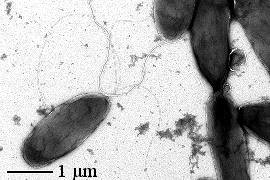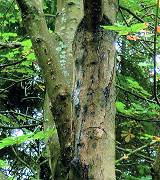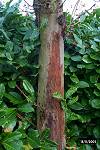Summary



Summary
This project investigated aspects of the biology of Pseudomonas syringae pv aesculi, the bacterial causal agent of horse chestnut bleeding canker:
- Development of a real-time PCR diagnostic test for P. syringae pv. aesculi has facilitated its rapid detection in symptomatic trees and provides a useful tool for studying host infection and survival outside the host.
- To better understand the evolutionary history and genetic make-up of this aggressive tree-infecting bacterium, draft genome sequences were generated for seven isolates of P. syringae pv. aesculi from Britain and continental Europe, and a type strain from India.
- Comparative genomics with other P. syringae pathovars aims to throw light on the important mechanisms by which bacteria have evolved to infect trees.
Main project findings
- Pseudomonas syringae pv. aesculi is most likely spread by wind and rain, and can infect horse chestnut through discontinuities in the bark, including lenticels, leaf scars, nodes and artificial wounds.
- Lesions caused by P. syringae pv. aesculi develop on young shoots of horse chestnut during the spring and summer and are centred mainly on lenticels, leaf scars and nodes. The lesions develop in the cortex and phloem and extend into the cambium to cause longitudinal spreading cankers.
- Pseudomonas syringae pv. aesculi is able to survive in soil for up to one year in the absence of host debris, and can tolerate lengthy periods of freezing at very low temperatures.
- Genomic comparisons suggest that P. syringae pv. aesculi probably spread to Europe in the early 2000s via an unknown pathway, with the epidemic across several countries resulting from the introduction of a single bacterial strain.
- Pseudomonas syringae pv. aesculi harbours unique sets of genes that are absent from other P. syringae pathovars that infect herbaceous hosts and which may be required for infection of a woody host.
Some practical recommendations
- Many horse chestnuts died as the epidemic spread across Britain in the early-mid 2000s; however, a good number of horse chestnuts still survive, albeit with varying severity of disease symptoms. Moderate to mildly affected trees should be monitored and badly cankered branches removed as necessary, particularly where they represent a safety risk.
- Tools, boots and vehicles should also be cleaned after working with symptomatic trees, since there is a risk that P. syringae pv. aesculi could be transmitted in soil, potentially over long distances.
Publications
Laue, B.E., Steele, H., Green, S. 2014. Survival, cold tolerance and seasonality of infection of European horse chestnut (Aesculus hippocastanum) by Pseudomonas syringae pv. aesculi. Plant Pathology (In Press).
Nowell, R.W., Green, S., Laue, B.E., Sharp, P.M. The extent of genome flux and its role in the differentiation of bacterial lineages. Genome Biology and Evolution. (In Press).
Green, S., Laue, B.E., Steele, H., Nowell, R.W. In Press. Horse Chestnut Bleeding Canker. Forestry Commission Research Note.
Green, S., Laue, B.E., Nowell, R., Steele, H. 2013. Horse chestnut bleeding canker – a 21st Century tree pathogen. Pp 783-794 In: T. Fenning (ed.), Challenges and Opportunities for the World’s Forests in the 21st Century, Forestry Sciences 81, DOI 10.1007/978-94-007-7076-8_35.
Green, S., Studholme, D.J., Laue, B.E., Dorati, F., Lovell, H., Arnold, D., Cottrell, J.E., Bridgett, S., Blaxter, M., Huitema, E., Thwaites, R., Sharp, P.M., Jackson, R.W., Kamoun, S. 2010. Comparative genome analysis provides insights into the evolution and adaptation of Pseudomonas syringae pv. aesculi on European horse chestnut. PLoS ONE 5(4): e10224. DOI:10.1371/journal.pone.0010224
Steele, H., Laue, B.E., MacAskill, G.A., Hendry, S.J., Green, S. 2010. Analysis of the natural infection of European horse chestnut ( Aesculus hippocastanum) by Pseudomonas syringae pv. aesculi. Plant Pathology 59 (6), 1005-1013.
Green, S., Laue, B., Fossdal, C.G., A’Hara, S., Cottrell, J. 2009. Infection of horse chestnut (Aesculus hippocastanum) by Pseudomonas syringae pv. aesculi and its detection by quantitative real-time PCR. Plant Pathology 58, 731-744.
Status
This project was established in 2008 and was completed in 2013.
Contact
People involved
- Dr Joan Cottrell, Forest Research
- Dr Sarah Green, Forest Research
- Dr Bridget Laue, Forest Research
- Grace MacAskill, Forest Research
- Reuben Nowell, PhD student, University of Edinburgh
- Professor Paul Sharp, University of Edinburgh
Funders and partners
![]()
This work is funded by the Forestry Commission as part of its Monitoring and Biosecurity programme, and the Forest Research CEO Innovation fund.
Forest Research is the industrial partner in a BBSRC-CASE PhD studentship on the evolutionary adaptations of Pseudomonas syringae to woody hosts. The student, Reuben Nowell, will commence in September 2010, and will be supervised by Dr Sarah Green, Forest Research, and Professor Paul Sharp at the Institute of Evolutionary Biology, University of Edinburgh.
Collaboration is also taking place with:
- The Genomics Facility, University of Edinburgh
- The Norwegian Forest and Landscape Institute
(which merged with the Norwegian Institute of Bioeconomy Research on 30 June 2015)
Forestry Commission policy
This has two main aims: the sustainable management of existing forests and woods and a steady expansion of woodland area to provide benefits for society and the environment. The Forestry Commission also has legal powers to prevent the entry of non-endemic pests and diseases of trees.
This project will advance our knowledge of the biology of an important and newly emerging bacterial tree pathogen in relation to its host and environment. Information resulting from this project will help guide the development of policy aimed at protecting Britain’s trees against exotic bacterial diseases.
General Content
What’s of interest

Bleeding Canker of Horse Chestnut
Practical and scientific information including:
- Its extent
- Symptoms
- Management advice
- Photos
- Bibliography
